Overview
This article delves into essential interview questions crucial for effective stakeholder management, underscoring their significance in cultivating relationships and facilitating clear communication during crises. By outlining ten pivotal questions, it guides businesses in prioritizing stakeholder needs, enhancing engagement, and ultimately fostering trust and collaboration—elements that are vital for achieving successful project outcomes.
Introduction
Effective stakeholder management stands as a cornerstone for the success of small and medium businesses, particularly in challenging times. By mastering the art of engaging with interested parties, organizations can build trust and enhance decision-making alongside project execution. This article explores ten essential interview questions designed to transform stakeholder interactions. Consider this: how well do you truly understand the needs and expectations of your stakeholders, and what strategies can you implement to foster stronger relationships?
Transform Your Small/ Medium Business: Key Strategies for Stakeholder Management Interviews
Effective management of interested parties is crucial for small and medium businesses, particularly in times of crisis. By adopting strategic approaches, organizations can strengthen their relationships with interested parties, ensuring their needs and expectations are prioritized. This proactive engagement not only builds trust but also leads to more efficient project execution and informed decision-making. For instance, companies that actively manage relationships with interested parties can reduce risks linked to financial difficulties, as 38% of firms fail due to or the inability to obtain funding. Moreover, employing real-time analytics can further enhance this process by offering immediate insights into the perspectives and needs of involved parties, facilitating a shortened decision-making cycle during crucial moments.
To enhance stakeholder engagement during crises, consider these essential interview questions:
- How do you prioritize the needs of involved parties during a crisis?
- Can you provide an instance of a successful strategy for involving interested parties executed during a past crisis?
- What methods do you use to communicate effectively with interested parties in high-pressure situations?
- How do you measure participant satisfaction and engagement?
- What role do you believe participant feedback plays in crisis management?
- How do you ensure openness with interested parties during difficult times?
- Can you describe a time when participant input significantly influenced a crisis response?
- What strategies do you use to restore confidence with involved parties after a crisis?
- How do you recognize important parties in a crisis situation?
- What tools or technologies do you use to improve participant interaction and involvement?
By focusing on interview stakeholder management questions, businesses can enhance their operations and outcomes, ultimately leading to more resilient and sustainable growth. Furthermore, utilizing real-time analytics and a dedication to implementing lessons learned can further improve relationships with interested parties, ensuring that organizations are well-prepared to tackle challenges effectively.
How Do You Build Relationships with Stakeholders?
Building robust connections with stakeholders requires addressing , consistent interaction, a deep understanding of their needs, and an unwavering commitment to reliability. Methods such as regular check-ins, personalized engagement, and active listening are essential for fortifying relationships when addressing interview stakeholder management questions.
For example, a comprehensive participant engagement plan that addresses interview stakeholder management questions can outline specific interaction strategies tailored to each group, ensuring that their unique needs are met. Organizations that prioritize communication with stakeholders achieve an impressive 79% success rate, significantly surpassing average initiatives. Moreover, effective engagement can drive a 20% increase in profitability, underscoring the tangible benefits of nurturing these relationships.
Consistent feedback from stakeholders is crucial for addressing interview stakeholder management questions, as it fosters trust and provides valuable insights that can propel business improvements and innovation.
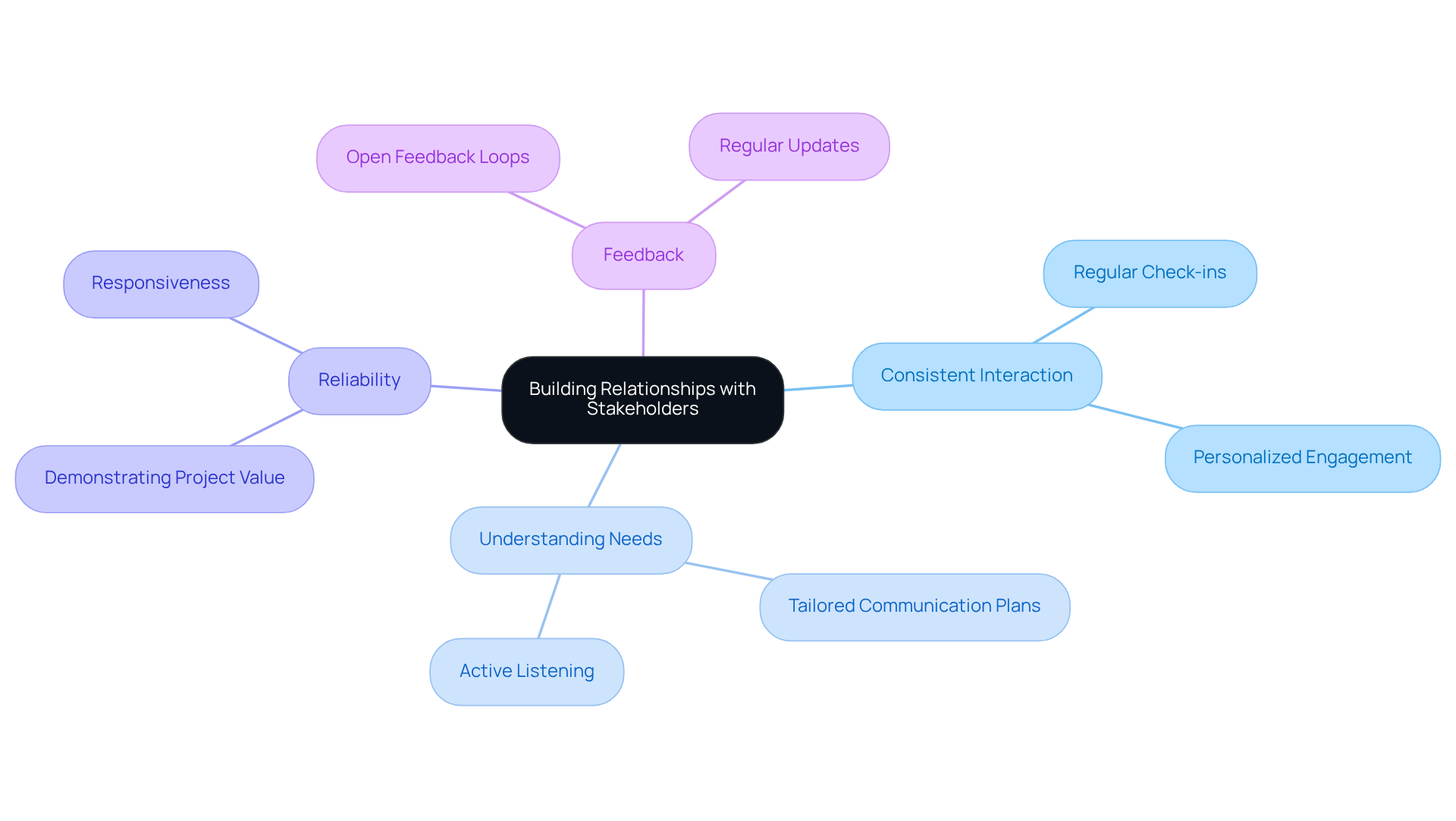
How Do You Receive Feedback from Stakeholders?
Gathering feedback from interested parties through interview stakeholder management questions is essential for informed decision-making and operational enhancement, particularly during a turnaround process. Effective methods such as surveys, one-on-one meetings, and structured feedback forms are crucial when addressing interview stakeholder management questions.
Establishing a comfortable atmosphere is vital for addressing interview stakeholder management questions; participants must feel secure and appreciated when sharing their insights. For instance, implementing can effectively gauge participant satisfaction and pinpoint areas needing enhancement. This approach not only encourages transparent dialogue but also strengthens connections, as organizations that prioritize interview stakeholder management questions from interested parties are 30% more likely to succeed with new initiatives.
Moreover, employing communication matrices can clarify roles and expectations, ensuring that interested parties are well-informed and engaged throughout the process of addressing interview stakeholder management questions. By actively seeking and valuing feedback through interview stakeholder management questions, businesses can drive continuous improvement and achieve sustainable growth.
Additionally, utilizing real-time business analytics via our client dashboard enables organizations to assess the efficiency of their feedback strategies and implement prompt modifications, ensuring that relationships with involved parties are nurtured and operational lessons are effectively applied.
As Jim Trinka and Les Wallace aptly state, 'Feedback is a gift. Ideas are the currency of our next success.' This underscores the importance of appreciating contributions from interested parties in the pursuit of organizational excellence.
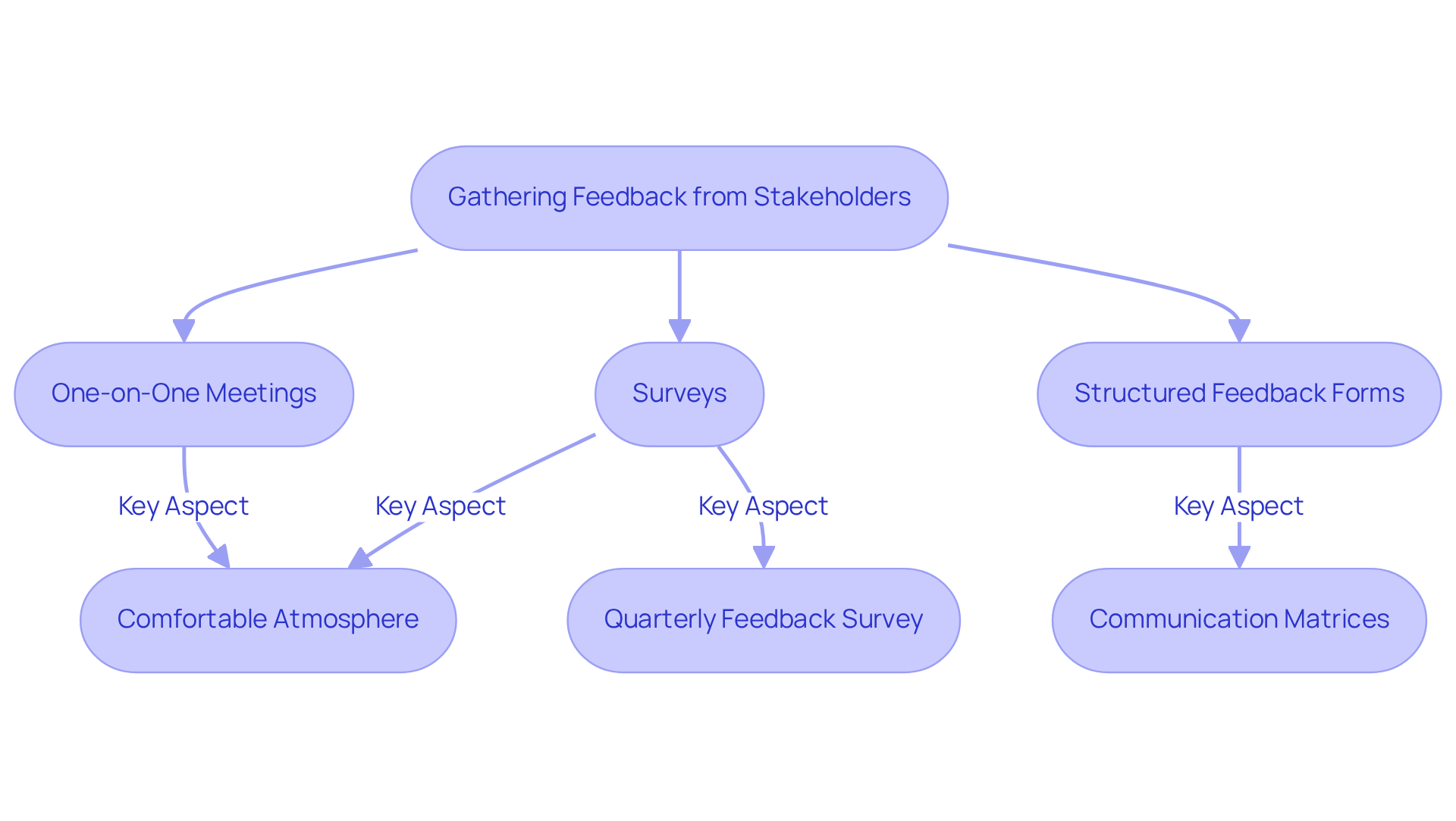
How Do You Identify Key Information to Share with Stakeholders?
Recognizing essential information to communicate with involved parties requires a comprehensive understanding of their interests and concerns, particularly when addressing interview stakeholder management questions. Key updates may encompass project milestones, financial performance metrics, and strategic changes that could influence their engagement. A practical strategy involves creating a matrix for engaging stakeholders, which includes interview stakeholder management questions to outline the specific information each participant needs and the optimal timing for sharing it. For instance, a matrix could categorize participants by their influence and interest levels, ensuring that high-priority individuals receive timely updates on critical developments.
Employing software applications to manage interview stakeholder management questions significantly enhances efficiency and clarity. These tools simplify information distribution and aid in monitoring participant involvement and feedback. Research indicates that organizations utilizing project management software experience a notable increase in project success rates, with effective interview stakeholder management questions being a vital contributor to this success.
In practice, companies have effectively leveraged engagement matrices to boost transparency and involvement. For example, a technology firm utilized a matrix to align its messaging strategy with the expectations of stakeholders, resulting in a 10% increase in satisfaction among them. This illustrates how can cultivate stronger relationships and improve overall project outcomes. Furthermore, integrating real-time analytics into your audience interaction strategy can further enhance decision-making processes. By consistently tracking the effectiveness of your messaging efforts through analytics, you can adjust your strategies in real time, ensuring that interested parties remain informed and engaged.

How Do You Stay Organized When Working with Multiple Stakeholders?
Maintaining order while overseeing various participants is essential for effective interaction and successful outcomes. Effective management tools, such as Trello and Asana, simplify the monitoring of communications, deadlines, and responsibilities. These platforms empower teams to:
- Assign tasks
- Set due dates
- Monitor progress in real-time
This ensures . Moreover, utilizing a shared calendar keeps all participants informed about significant dates and milestones, promoting transparency and accountability. By leveraging these tools, organizations can enhance collaboration and reduce the likelihood of miscommunication, ultimately leading to improved participant engagement and superior project results.
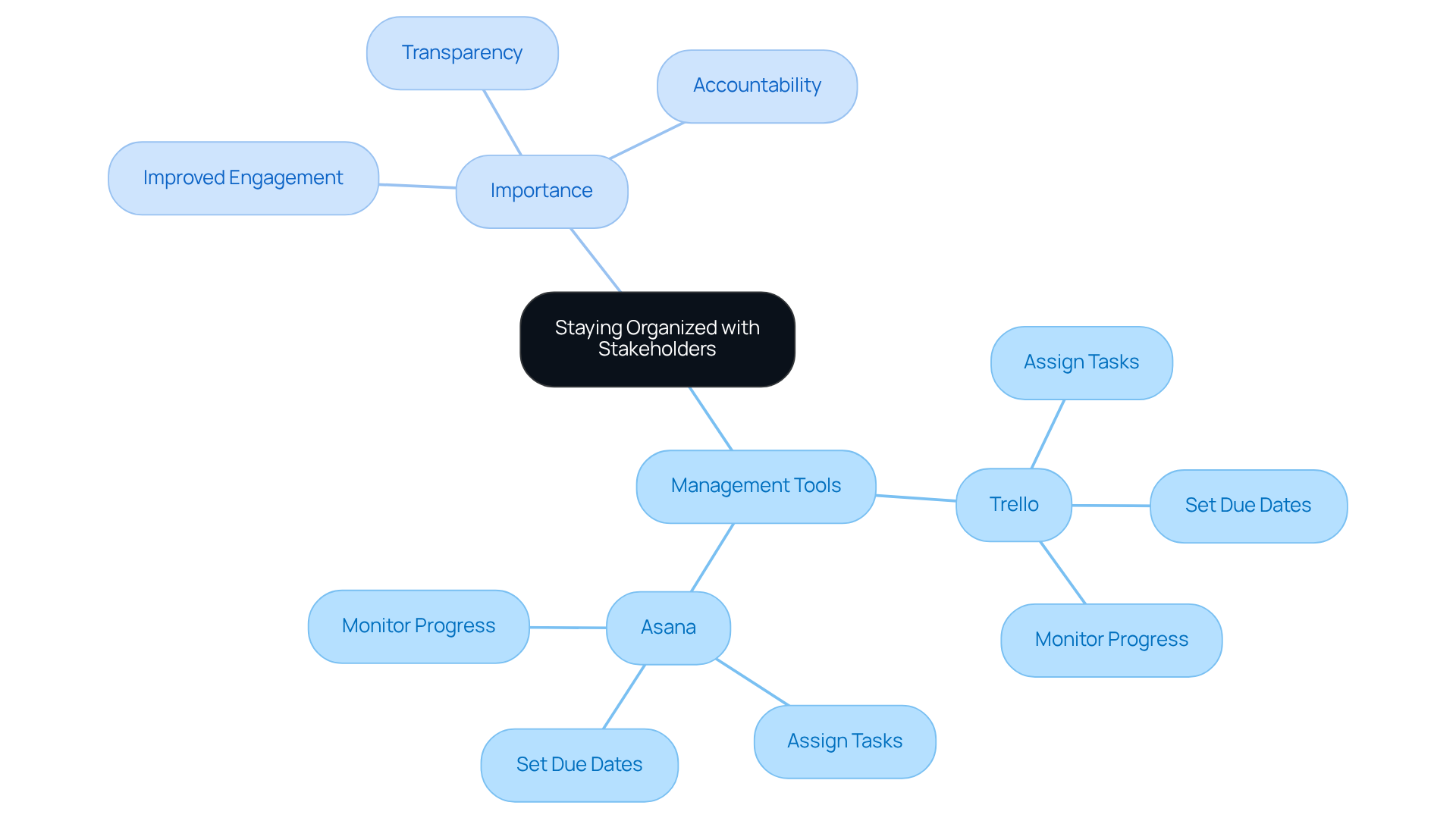
Can You Describe Your Communication Style?
Describing your interaction style entails articulating how you convey information and engage with various stakeholders. Candidates must emphasize their adaptability, tailoring their approach to suit the audience—whether delivering formal presentations to executives or engaging in casual discussions with team members.
For instance, a consultant might highlight their commitment to using clear, concise language and active listening skills, essential for fostering open dialogue. As Stephen R. Covey states, effective dialogue is about listening to understand rather than to reply. This adaptability not only improves understanding but also fosters trust, as is vital for successful negotiation and collaboration.
Moreover, experts concur that acknowledging the distinctive requirements of each participant can greatly enhance project results and team interactions. Additionally, as mentioned by Jeremy Pollack, showing gratitude in interactions promotes trust and cooperation among involved parties. Given that 85% of employees experience some kind of conflict at work, it is imperative for candidates to demonstrate their proficiency in adjusting their communication style accordingly.
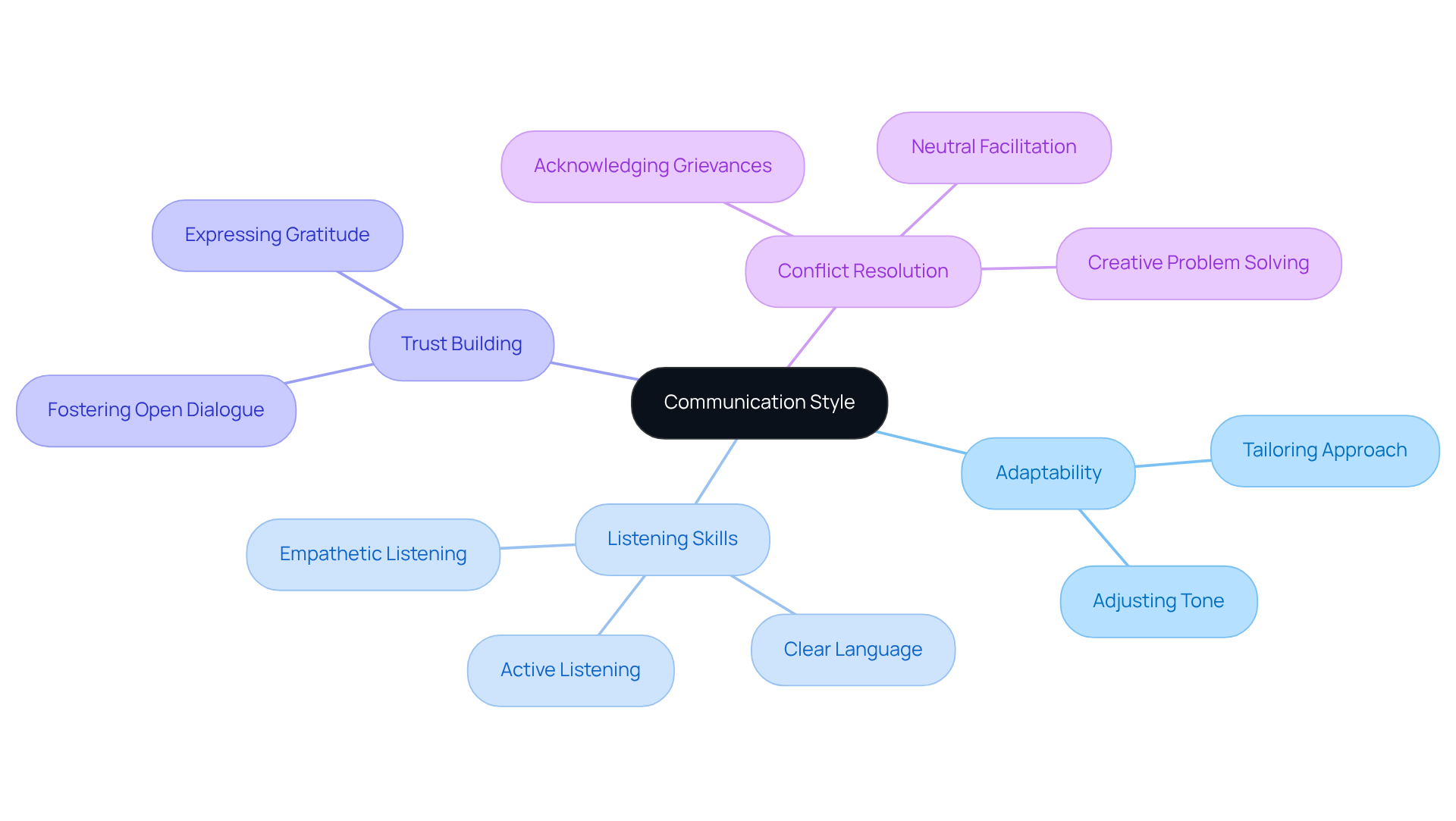
How Do You Handle Conflicting Opinions Among Stakeholders?
Navigating conflicting opinions among interested parties often requires answering interview stakeholder management questions with a blend of diplomacy and negotiation skills. Effective techniques for addressing interview stakeholder management questions include:
- Facilitating open discussions
- Identifying common ground
- Proposing mutually beneficial compromises
For instance, might suggest arranging a mediation session, allowing participants to express their viewpoints and collaboratively develop solutions. Frequent updates are crucial in this process, as they keep participants informed and engaged, fostering a sense of inclusion and trust.
By utilizing the client dashboard, which provides real-time business analytics, CFOs can consistently monitor participant sentiments and adjust strategies accordingly, ensuring that decisions are data-driven and timely. Moreover, employing mediation techniques—such as active listening and reframing issues—can help de-escalate tensions and promote constructive dialogue.
Ultimately, the ability to diplomatically handle differing perspectives by using interview stakeholder management questions not only enhances relationships with interested parties but also drives success, applying lessons learned from the turnaround process while ensuring a reduced decision-making cycle.
How Do You Ensure Stakeholder Engagement Throughout a Project?
Ensuring the participation of interested parties throughout a project is crucial and can be effectively achieved by addressing interview stakeholder management questions, along with regular updates, feedback sessions, and active involvement in decision-making processes.
A consultant may recommend developing a participant involvement plan that addresses interview stakeholder management questions to outline how and when contributors will be engaged, ensuring they feel valued and heard.
At Transform Your Small/Medium Business, we initiate with a comprehensive business assessment that incorporates interview stakeholder management questions to align key participants and gain deeper insights into the business context beyond mere figures.
This method not only streamlines decision-making but also enables real-time analytics to monitor performance and reinforce strengths.
By consistently engaging with interested parties and implementing turnaround insights, we foster a collaborative atmosphere that enhances interaction and builds lasting connections.
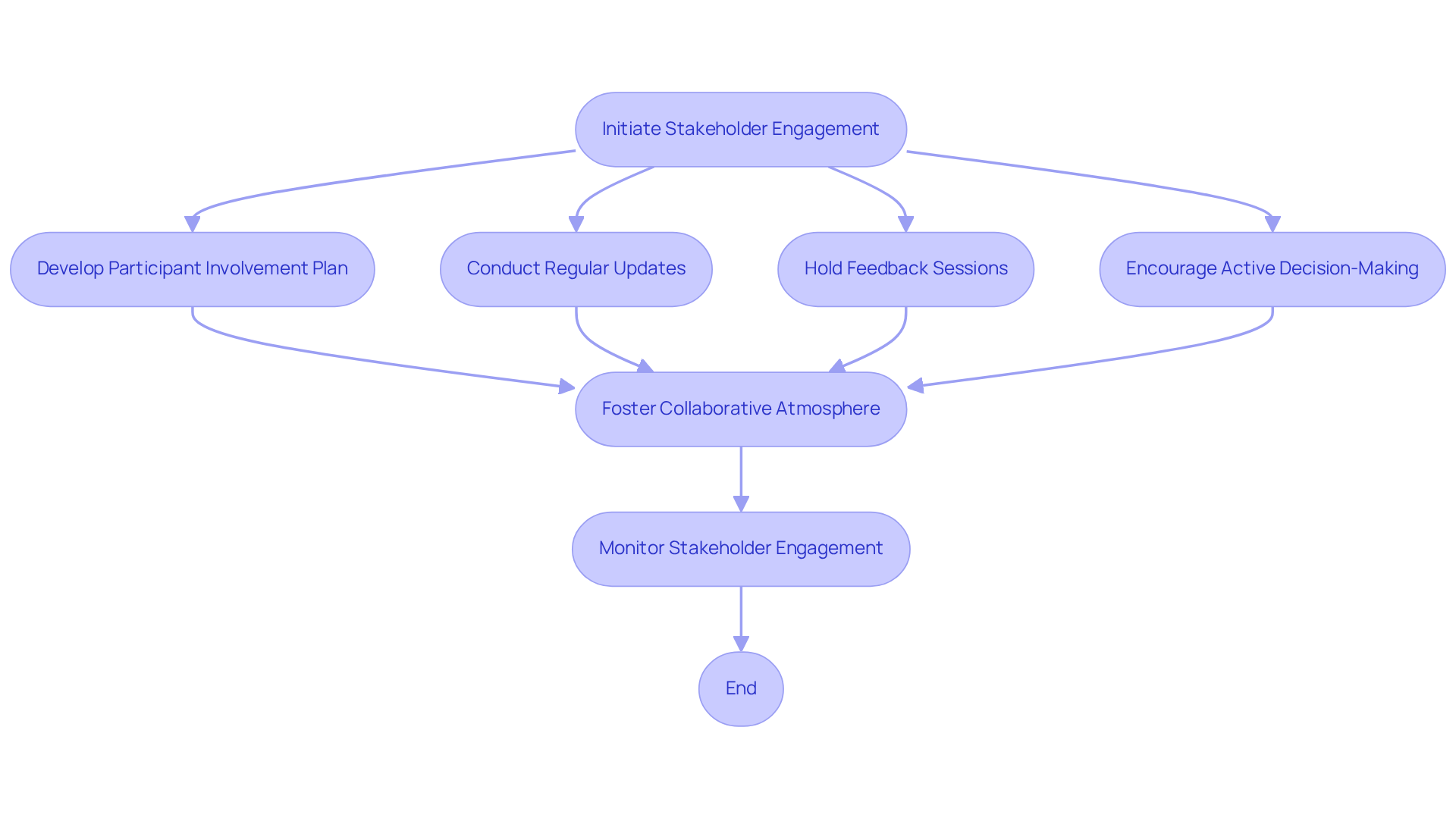
How Do You Manage Stakeholder Expectations?
Effectively managing the expectations of interested parties hinges on clear communication regarding objectives, timelines, and potential challenges. Employing SMART (Specific, Measurable, Achievable, Relevant, Time-bound) goals serves as a reliable method to align these expectations. For instance, a manager may set a specific objective to enhance participant involvement by 40% through quarterly meetings, a strategy that has been shown to significantly bolster trust and collaboration.
Moreover, regular check-ins are crucial; they enable a reassessment of expectations and necessary adjustments, promoting a proactive approach to managing stakeholders. Utilizing real-time business analytics through our client dashboard provides valuable insights into performance, empowering teams to make informed decisions swiftly.
By prioritizing clear communication, structured goal-setting, and leveraging analytics for ongoing performance monitoring, organizations can cultivate stronger relationships with stakeholders, ultimately driving .
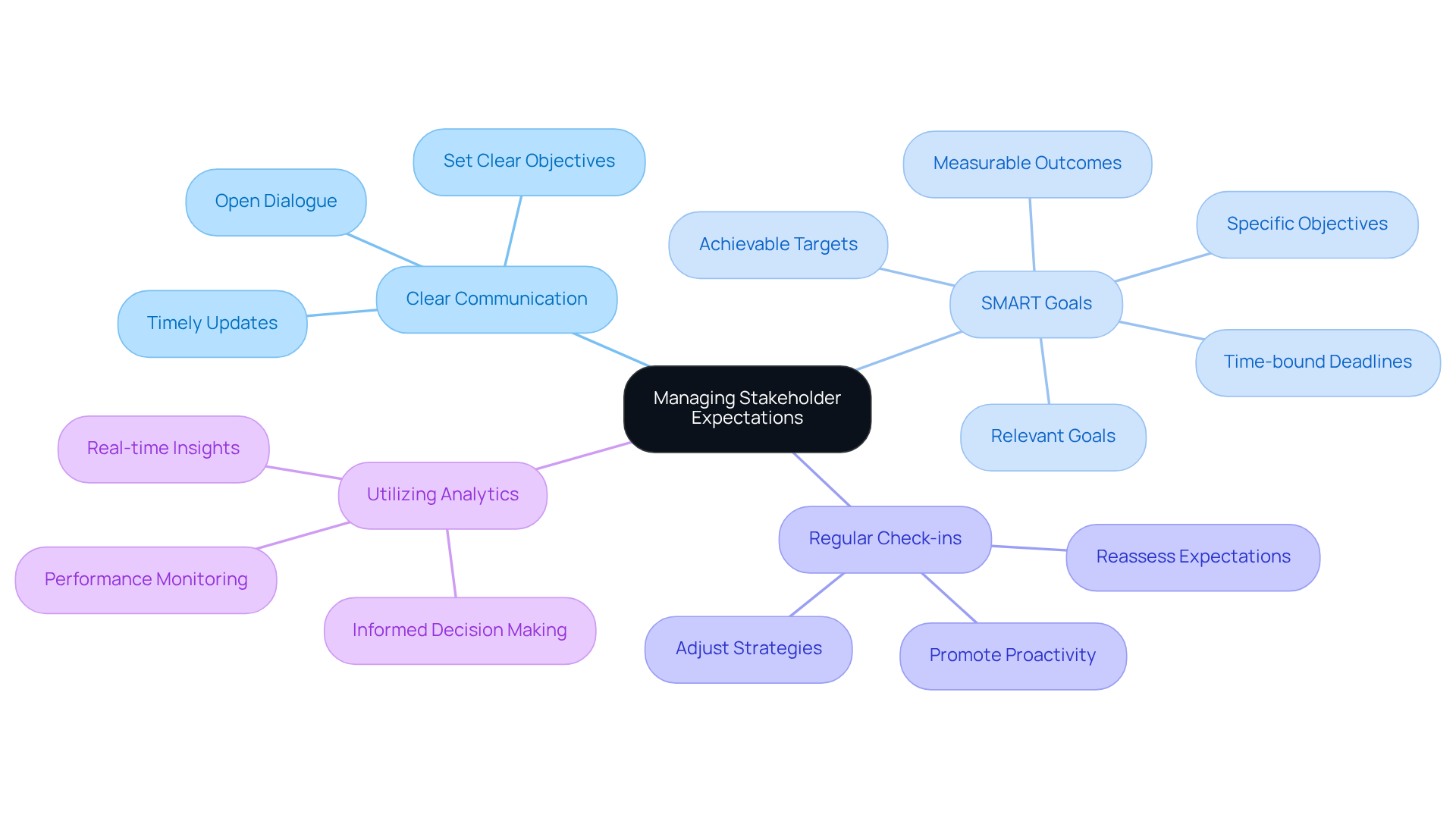
How Do You Ensure Transparency with Stakeholders?
Openness with involved parties is essential for cultivating trust and cooperation. Regular updates and open discussions about challenges not only keep involved parties informed but also demonstrate a commitment to accountability. Moreover, utilizing tools like dashboards offers into project progress and financial status, thereby improving clarity and engagement. These dashboards serve as a visual representation of key metrics, allowing stakeholders to track developments and make informed decisions. By prioritizing transparency, organizations can cultivate stronger relationships, mitigate risks, and drive innovation. Consequently, this approach ultimately leads to sustainable growth.
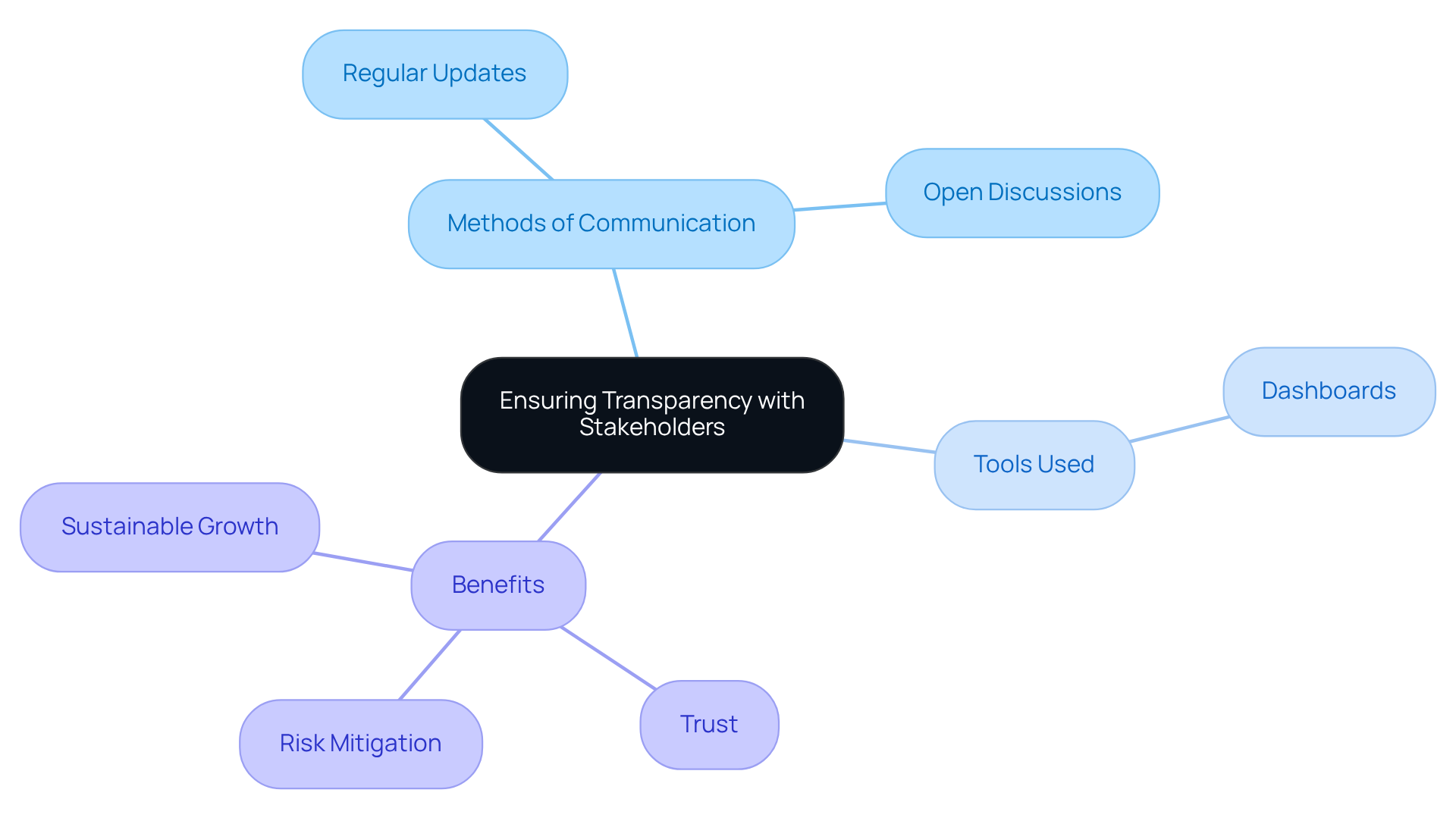
Conclusion
Effective stakeholder management is crucial for the success of small and medium businesses, especially in challenging times. By employing strategic approaches to engage with interested parties, organizations can build trust, enhance decision-making, and improve project execution. The ten essential interview questions presented in this article act as a roadmap for fostering stronger relationships and ensuring that stakeholder needs and expectations are prioritized.
Throughout this discussion, key insights have emerged regarding the necessity of prioritizing stakeholder needs during crises, utilizing effective communication strategies, and gathering valuable feedback. Moreover, the article underscores the importance of transparency and organization in maintaining stakeholder engagement, alongside the need to adapt communication styles to suit diverse audiences. By addressing these components, businesses can significantly enhance their interactions and outcomes.
Ultimately, the journey toward effective stakeholder management is an ongoing process that demands commitment and adaptability. Organizations are encouraged to leverage the insights gained from this article to refine their strategies, ensuring they not only meet but exceed stakeholder expectations. By prioritizing strong relationships and open communication, businesses can navigate challenges more effectively and pave the way for sustainable growth and success.
Frequently Asked Questions
Why is stakeholder management important for small and medium businesses?
Effective stakeholder management is crucial for small and medium businesses, especially during crises, as it helps strengthen relationships with interested parties, prioritizes their needs, builds trust, and leads to more efficient project execution and informed decision-making.
What are some risks associated with poor stakeholder management?
Poor stakeholder management can lead to increased risks, such as financial difficulties. For instance, 38% of firms fail due to cash flow problems or the inability to obtain funding.
How can real-time analytics enhance stakeholder management?
Real-time analytics provide immediate insights into the perspectives and needs of involved parties, facilitating a shortened decision-making cycle during critical moments.
What are some essential interview questions for enhancing stakeholder engagement during crises?
Essential questions include: How do you prioritize the needs of involved parties during a crisis? Can you provide an instance of a successful strategy for involving interested parties during a past crisis? What methods do you use to communicate effectively with interested parties in high-pressure situations? How do you measure participant satisfaction and engagement? What role does participant feedback play in crisis management? How do you ensure openness with interested parties during difficult times? Can you describe a time when participant input significantly influenced a crisis response? What strategies do you use to restore confidence with involved parties after a crisis? How do you recognize important parties in a crisis situation? What tools or technologies do you use to improve participant interaction and involvement?
What methods can be used to build relationships with stakeholders?
Building relationships with stakeholders requires consistent interaction, understanding their needs, and reliability. Methods include regular check-ins, personalized engagement, and active listening.
How does effective stakeholder engagement impact business success?
Organizations that prioritize communication with stakeholders achieve a 79% success rate and can drive a 20% increase in profitability, highlighting the tangible benefits of nurturing these relationships.
What are effective methods for receiving feedback from stakeholders?
Effective methods include surveys, one-on-one meetings, and structured feedback forms. Creating a comfortable atmosphere for sharing insights is also important.
How can organizations gauge participant satisfaction and identify areas for improvement?
Implementing quarterly feedback surveys can effectively gauge participant satisfaction and identify areas needing enhancement, encouraging transparent dialogue and strengthening connections.
What role does feedback play in stakeholder management?
Feedback fosters trust and provides valuable insights that can lead to business improvements and innovation, making it essential for informed decision-making and operational enhancement.
How can organizations assess the efficiency of their feedback strategies?
Utilizing real-time business analytics via client dashboards allows organizations to evaluate the effectiveness of their feedback strategies and make prompt modifications as needed.




